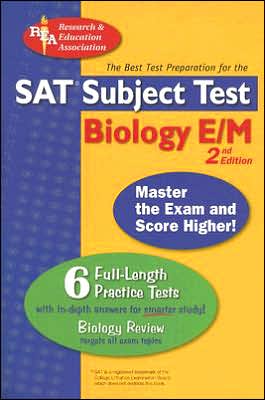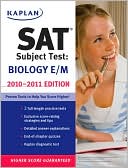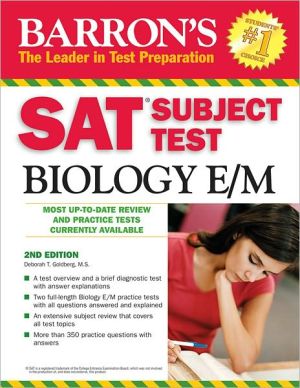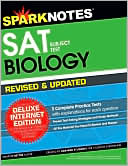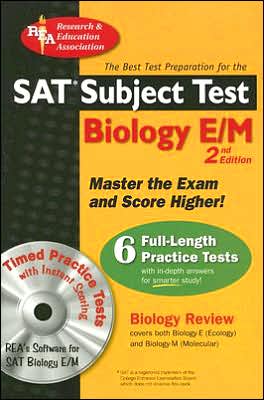SAT Subject Test: Biology E/M (REA) -- The Best Test Prep for the SAT
Get SAT Street Smart! Our savvy exam experts show you how to master the test and score higher.\ This newly revised 2nd edition contains the latest information on the new SAT Subject Test for Biology E/M. The study guide comes complete with an in-depth review of the chemistry of life, cells, genetics, biodiversity, classification, and more. Build your test-taking skills with 6 full-length practice exams. Study smarter with detailed answers to every practice question. Each question is explained...
Search in google:
Get SAT Street Smart! Our savvy exam experts show you how to master the test and score higher. This newly revised 2nd edition contains the latest information on the new SAT Subject Test for Biology E/M. The study guide comes complete with an in-depth review of the chemistry of life, cells, genetics, biodiversity, classification, and more. Build your test-taking skills with 6 full-length practice exams. Study smarter with detailed answers to every practice question. Each question is explained in an easy-to-understand format. Follow up your study with REA's test-taking strategies, powerhouse drills and schedule guidelines that get you ready for test day.DETAILS - New, updated 2nd edition comes complete with all the latest SAT information - 6 full-length practice exams - Concentrated subject reviews that hone test skills & max study efforts - Thoroughly detailed explanations for all practice exam questions - Packed with test-taking strategies, powerhouse drills & schedule guidelines
EXCERPT\ About Research & Education Association\ Research & Education Association (REA) is an organization of educators, scientists, and engineers specializing in various academic fields. Founded in 1959 with the purpose of disseminating the most recently developed scientific information to groups in industry, government, high schools, and universities, REA has since become a successful and highly respected publisher of study aids, test preps, handbooks, and reference works.\ REA's Test Preparation series includes study guides for all academic levels in almost all disciplines. Research & Education Association publishes test preps for students who have not yet completed high school, as well as high school students preparing to enter college. Students from countries around the world seeking to attend college in the United States will find the assistance they need in REA's publications. For college students seeking advanced degrees, REA publishes test preps for many major graduate school admission examinations in a wide variety of disciplines, including engineering, law, and medicine. Students at every level, in every field, with every ambition can find what they are looking for among REA's publications.\ While most test preparation books present practice tests that bear little resemblance to the actual exams, REA's series presents tests that accurately depict the official exams in both degree of difficulty and types of questions. REA's practice tests are always based upon the most recently administered exams, and include every type of question that can be expected on the actual exams.\ REA's publications and educational materials are highly regarded and continually receive an unprecedented amount of praise from professionals, instructors, librarians, parents, and students. Our authors are as diverse as the fields represented in the books we publish. They are well-known in their respective disciplines and serve on the faculties of prestigious high schools, colleges, and universities throughout the United States and Canada.\ INTRODUCTION: PREPARING FOR THE SAT II: BIOLOGY E/M SUBJECT TEST\ Who Takes the Test and What Is It Used For?\ Students planning to attend college should take the SAT II: Biology E/M Subject Test if:\ (1) Any of the colleges they apply to require the test for admission;\ OR\ (2) The student wishes to demonstrate proficiency in Biology.\ The SAT II: Biology E/M exam is designed for students who have taken one year of college preparatory biology (either a general survey course or one with emphasis on Ecology or Molecular Biology), a one-year course in algebra, and have laboratory experience. However, due to the variation in high school biology courses, most students will encounter questions that test material with which they are not familiar.\ Who Administers The Test?\ The SAT II: Biology E/M Subject Test is developed by the College Board and administered by Educational Testing Service (ETS). The test development process involves the assistance of educators throughout the country, and is designed and implemented to ensure that the content and difficulty level of the test are appropriate.\ When Should the SAT II: Biology E/M be Taken?\ If you are applying to a college that requires Subject Test scores as part of the admissions process, you should take the SAT II: Biology E/M Subject Test toward the end of your junior year or at the beginning of your senior year. If your scores are being used only for placement purposes, you may be able to take the test in the spring of your senior year. For more information, be sure to contact the colleges to which you are applying.\ When and Where is the Test Given?\ The SAT II: Biology E/M Subject Test is administered six times a year at many locations throughout the United States; most test centers are at high schools. For more information on specific testing dates and locations, consult the registration bulletin or your high school guidance counselor.\ To receive information on upcoming administrations of the exam, consult the publication Taking the SAT II: Subject Tests, which may be obtained from your guidance counselor or by contacting:\ College Board SAT Program P.O. Box 6200\ Princeton, NJ 08541-6200\ Phone: (609) 771-7600\ E-mail: sat@info.collegeboard.com Website: http://www.collegeboard.com\ Is There a Registration Fee?\ Yes. There is a registration fee to take the SAT II: Biology E/M. Consult the publication Taking the SAT II: Subject Tests for information on the fee structure. Financial assistance may be granted in certain situations. To find out if you qualify and to register for assistance, contact your academic advisor.\ Can I Use a Calculator?\ Calculators are not permitted on the SAT II: Biology E/M. The metric system of units is used, so review of metric units may be helpful.\ The Biology E/M is a one-hour exam consisting of 80 multiple-choice questions. Each question has five possible answer choices, lettered (A) through (E). The common core, which appears on both the Biology-E and the Biology-M Tests, consists of 60 questions. It covers Cellular and Molecular Biology, Ecology, Classical Genetics, Organismal Biology, and Evolution and Diversity. Its emphasis is on Organismal Biology.\ In addition to the common core, you will be required to take a specialty section comprised of 20 questions, making 80 the total number of questions you will be answering on any form, or in any administration, of the SAT II: Biology E/M. One of these specialty sections is the Biology-E Test, which covers principles and applications of Ecology. The other specialty section is the Biology-M Test which covers concepts and principles of Molecular Biology. Remember, these specialty sections are taken in addition to the common core. However, you will not be able to take both the Biology-E and the Biology-M Tests in the same administration.\ The following chart summarizes the distribution of topics covered on the SAT II: Biology E/M exam:\ Topics Covered in Core Section / Percentage of Test /Number of Questions\ Cellular and Molecular Biology / 12% / 9-10 questions Ecology / 12% / 9-10 questions Classical Genetics / 10% / 8 questions Organismal Biology / 30% / 24 questions Evolution and Diversity / 11% / 8-9 questions Ecology (Biology-E Test) / 25% / 20 questions OR Molecular Biology (Biology-M Test) / 25% / 20 questions\ Note: Every administration of the Biology E/M Test includes 60 common core questions.\ This book will provide you with an accurate and complete representation of the SAT II: Biology E/M Subject Test. Inside you will find a course review designed to provide you with the information and strategies needed to do well on the exam, as well as six full-length practice tests based on the actual exam. Three of our model tests are aimed specifically at students taking the Biology-E Test, and three are geared toward those taking the Biology-M Test. REA's practice tests contain every type of question you can expect to encounter on the SAT II: Biology E/M Test. Following each test, you will find an answer key with detailed explanations to help you master the test material.\ What Do I Study First?\ Remember that the SAT II: Biology E/M Subject Test is designed to test knowledge that has been acquired throughout your education. Therefore, the best way to prepare for the exam is to refresh yourself by? thoroughly studying our review material and taking the sample tests provided in this book. They will familiarize you with the types of questions, directions, and format of the SAT II: Biology E/M Subject Test.\ To begin your studies, read over the review and the suggestions for test-taking, take one of the practice tests (Biology-E if you are studying Ecology, or Biology-M if you are studying Molecular Biology) to determine your area(s) of weakness, and then restudy the review material, focusing on your specific problem areas. The course review includes the information you need to know when taking the exam. Be sure to take the remaining practice tests to further test yourself and become familiar with the format of the SAT II: Biology E/M Subject Test.\ When Should I Start Studying?\ It is never too early to start studying for the SAT II: Biology E/M test. The earlier you begin, the more time you will have to sharpen your skills. Do not procrastinate! Last-minute studying and cramming is not an effective way to study, since it does not allow you the time needed to learn the test material. The sooner you learn the format of the exam, the more comfortable you will be when you take the exam.\ TEST TAKING TIPS\ Although you may be unfamiliar with standardized tests such as the SAT II: Biology E/M Subject Test, there are many ways to acquaint yourself with this type of examination and help alleviate your test-taking anxieties.\ Become comfortable with the format of the exam. When you are practicing to take the SAT II: Biology E/M Subject Test, simulate the conditions under which you will be taking the actual test. Stay calm and pace yourself. After simulating the test only a couple of times, you will boost your chances of doing well, and you will be able to sit down for the actual exam with much more confidence.\ Know the directions and format for each section of the test. Familiarizing yourself with the directions and format of the exam will not only save you time, but will also ensure that you are familiar enough with the SAT II: Biology E/M Subject Test to avoid nervousness (and the mistakes caused by being nervous).\ Do your scratchwork in the margins of the test booklet. You will not be given scrap paper during the exam, and you may not perform scratchwork on your answer sheet. Space is provided in your test booklet to do any necessary work or draw diagrams.\ If you are unsure of an answer, guess. However, if you do guess - guess wisely. Use the process of elimination by going through each answer to a question and ruling out as many of the answer choices as possible. By eliminating three answer choices, you give yourself a fifty-fifty chance of answering correctly since there will only be two choices left from which to make your guess.\ Mark your answers in the appropriate spaces on the answer sheet. Each numbered row will contain five ovals corresponding to each answer choice for that question. Fill in darkly, completely, and neatly the circle that corresponds to your answer. You can change your answer, but remember to completely erase your old answer. Any stray lines or unnecessary marks may cause the machine to score your answer incorrectly. When you have finished working on a section, you may want to go back and check to make sure your answers correspond to the correct questions. Marking one answer in the wrong space will throw off the rest of your test, whether it is graded by machine or by hand. When taking the test, you may want to occasionally check your answer sheet to be sure that you are filling in the oval that corresponds to the question you are answering. This is especially important for those taking the SAT II: Biology E/M Test. For the Biology-M Test, you will need to fill in ovals 81-100, therefore, ovals 61-80 on your answer sheet will remain blank. Be sure to pay close attention to this when you begin the Biology-M Test.\ You don't have to answer every question. You are not penalized if you do not answer every question. The only penalty results from answering a question incorrectly. Try to use the guessing strategy, but if you are truly stumped by a question, remember that you do not have to answer it.\ Work quickly and steadily. You have a limited amount of time to work on each section, so you need to work quickly and steadily. Avoid focusing on one problem for too long.\ Taking the practice tests in this book will help you to learn how to budget your time and pace yourself.\ Keep track of your scores. By doing so, you will be able to gauge your progress and discover general weaknesses in particular sections. You should carefully study the reviews that cover your areas of difficulty, as this will build your skills in those areas. To help you budget your time for studying, we have provided for you a detailed study schedule.\ The SAT II: Biology E/M Test, like all other Subject Tests, is scored on a 200-800 scale.\ Before the Test\ Make sure you know where your test center is well in advance of your test day so you do not get lost on the day of the test. On the night before the test, gather together the materials you will need the next day:\ - Your admission ticket\ - Two forms of identification (e.g., driver's license, student identification card, or current alien registration card)\ - Two No. 2 pencils with erasers\ - Directions to the test center\ - A watch (if you wish) but not one that makes noise, as it may disturb other test-takers\ On the day of the test, you should wake up early (after a good night's rest) and have breakfast. Dress comfortably, so that you are not distracted by being too hot or too cold while taking the test. Also, plan to arrive at the test center early. This will allow you to collect your thoughts and relax before the test, and will also spare you the stress of being late. If you arrive after the test begins, you will not be admitted to the test center and you will not receive a refund.\ During the Test\ When you arrive at the test center, try to find a seat where you feel most comfortable. Follow all the rules and instructions given by the test supervisor. If you do not, you risk being dismissed from the test and having your scores canceled.\ Once all the test materials are passed out, the test instructor will give you directions for filling out your answer sheet. Fill this sheet out carefully since this information will appear on your score report.\ After the Test\ When you have completed the SAT II: Biology E/M Subject Test, you may hand in your test materials and leave. Then, go home and relax! You should receive your score report which includes your scores, percentile ranks, and interpretive information about three weeks after you take the test.
TABLE OF CONTENTS INTRODUCTION: PREPARING FOR THE SAT II: BIOLOGY E/M SUBJECT TEST About the SAT II: Biology E/M Format of the SAT II: Biology E/M About this Book How to Use this Book Test-Taking Tips Study Schedule Scoring the SAT II: Biology E/M Scoring Worksheet The Day of the Test CHAPTER 1 - CHEMISTRY OF LIFE General Chemistry Definitions Chemical Bonds Acids and Bases Chemical Changes Laws of Thermodynamics Organic Chemistry Biochemical Pathways Photosynthesis Cellular Respiration ATP and NAD The Respiratory Chain (Electron Transport System)Anaerobic Pathways Molecular Genetics DNA: The Basic Substance of Genes CHAPTER 2 - THE CELL Cell Structure and Function Prokaryotic Cells Eukaryotic Cells Exchange of Materials Between Cell and Environment Cellular Division Equipment and Techniques Units of Measurement Microscopes CHAPTER 3 - GENETICS: THE SCIENCE OF HEREDITY Mendelian Genetics Definitions Laws of Genetics Patterns of Inheritance, Chromosomes, Genes, and Alleles The Chromosome Principle of Inheritance Genes and the Environment Improving the Species Sex Chromosomes Sex-linked Characteristics Inheritance of Defects Modern Genetics How Living Things are Classified CHAPTER 4 - A SURVEY OF BACTERIA, PROTISTS, AND FUNGI Diversity and Characteristics of the Monera Kingdom Archaebacteria Eubacteria The Kingdom Protista The Kingdom Fungi CHAPTER 5 - A SURVEY OF PLANTS Diversity, Classification, and Phylogeny of the Plant Kingdom Adaptations to Land The Life Cycle (Life History): Alternation of Generations in Plants Anatomy, Morphology, and Physiology of Vascular Plants Transport of Food in Vascular Plants Plant Tissues Reproduction and Growth in Seed Plants Photosynthesis Plant Hormones: Types, Functions, Effects on Plant Growth Environmental Influences on Plants and Plant Responses to Stimuli CHAPTER 6 - ANIMAL TAXONOMY AND TISSUES Diversity, Classification, and Phylogeny Survey of Acoelomate, Pseudocoelomate, Protostome, and Deuterostome Phyla Structure and Function of Tissues, Organs, and Systems Animal Tissues Nerve Tissue Blood Epithelial Tissue Connective (Supporting) Tissue CHAPTER 7 - DIGESTION/NUTRITION The Human Digestive System Ingestion and Digestion Digestive System Disorders Human Nutrition Carbohydrates Fats Proteins Vitamins CHAPTER 8 - RESPIRATION AND CIRCULATION Respiration in Humans Breathing Lung Disorders Respiration in Other Organisms Circulation in Humans Blood Lymph Circulation of Blood Transport Mechanisms in Other Organisms CHAPTER 9 - THE ENDOCRINE SYSTEM The Human Endocrine System Thyroid Gland Parathyroid Gland Pituitary Gland Pancreas Adrenal Glands Pineal Gland Thymus Gland Sex Glands Hormones of the Alimentary Canal Disorders of the Endocrine System The Endocrine System in Other Organisms CHAPTER 10 - THE NERVOUS SYSTEM The Nervous System Neurons Nerve Impulse Synapse Reflex Arc The Human Nervous System The Central Nervous System The Peripheral Nervous System Some Problems of the Human Nervous System Relationship Between the Nervous System and the Endocrine System The Nervous Systems In Other Organisms CHAPTER 11 - SENSING THE ENVIRONMENT Components of Nervous Coordination Photoreceptors Vision Defects Chemoreceptors Mechanoreceptors Receptors in Other Organisms CHAPTER 12 - THE EXCRETORY SYSTEM Excretion in Humans Skin Lungs Liver Urinary System Excretory System Problems Excretion in Other Organisms CHAPTER 13 - THE SKELETAL SYSTEM The Skeletal System Functions Growth and Development Axial Skeleton Appendicular Skeleton Articulations (Joints)The Skeletal Muscles Functions Structure of a Skeletal Muscle Mechanism of a Muscle Contraction CHAPTER 14- HUMAN PATHOLOGY Diseases of Humans How Pathogens Cause Disease Host Defense Mechanisms Diseases Caused by Microbes Sexually Transmitted Diseases Diseases Caused by Worms Other Diseases CHAPTER 15 - REPRODUCTION AND DEVELOPMENT Reproduction Reproduction in Humans Development Stages of Embryonic Development Reproduction and Development in Other Organisms CHAPTER 16 - EVOLUTION The Origin of Life Evidence for Evolution Historical Development of the Theory of Evolution The Five Principles of Evolution Mechanisms of Evolution Mechanisms of Speciation Evolutionary Patterns How Living Things Have Changed The Record of Prehistoric Life Geological Eras Human Evolution CHAPTER 17 - BEHAVIOR Behavior of Animals Learned Behavior Innate Behavior Voluntary Behavior Plant Behavior Behavior of Protozoa Behavior of Other Organisms Drugs and Human Behavior CHAPTER 18 - PATTERNS OF ECOLOGY Ecology Populations Life History Characteristics Population Structure Population Dynamics Communities Components of Communities Interactions within Communities Consequences of Interactions Ecosystems Definitions Energy Flow Through Ecosystems Biogeochemical Cycles Hydrological Cycle Nitrogen Cycle Carbon Cycle Phosphorus Cycle Types of Ecosystems Human Influences on Ecosystems Use of Non-renewable Resources Use of Renewable Resources Use of Synthetic Chemicals Suggested Readings PRACTICE TESTS Biology-E Practice Tests SAT II: Biology E/M Practice Test 1SAT II: Biology E/M Practice Test 2 SAT II: Biology E/M Practice Test 3Biology-M Practice Tests SAT II: Biology E/M Practice Test 4 SAT II: Biology E/M Practice Test 5SAT II: Biology E/M Practice Test 6ANSWER SHEETS
